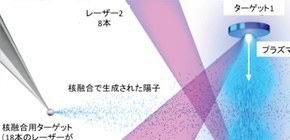
Successful Observation of Turbulent Magnetic Fields via Magnetic Instability
International joint research project performed experiments using the large-scale laser system, OMEGA
SAKAWA Youichi , Associate Professor, and TAKABE Hideaki , Professor at the Institute of Laser Engineering, Osaka University, succeeded in experiments using the large-scale laser system in the US, OMEGA, under an international joint-research project by 8 research institutes in Japan, Europe, and the US, in the creation of ultra-high-speed counter-streaming plasma flows of 1,000 km/sec, and the observation of turbulent magnetic fields via magnetic instability. This group has verified that it is possible to examine in the future experiments on NIF, the world-largest laser in the US, the formation of turbulent magnetic fields and the resultant shock wave, with the similar mechanism as those formed after the explosion of supernovas, and examine the mechanism for cosmic-ray acceleration by shock waves, in laboratories.
Abstract
Collisionless shocks can be produced as a result of strong magnetic fields in a plasma flow, and therefore are common in many astrophysical systems. The Weibel instability is one candidate mechanism for the generation of sufficiently strong fields to create a collisionless shock. Despite their crucial role in astrophysical systems, observation of the magnetic fields produced by Weibel instabilities in experiments has been challenging. Using a proton probe to directly image electromagnetic fields, we present evidence of Weibel-generated magnetic fields that grow in opposing, initially unmagnetized plasma flows from laser-driven laboratory experiments. Three-dimensional particle-in-cell simulations reveal that the instability efficiently extracts energy from the plasma flows, and that the self-generated magnetic energy reaches a few percent of the total energy in the system. This result demonstrates an experimental platform suitable for the investigation of a wide range of astrophysical phenomena, including collisionless shock formation in supernova remnants, large-scale magnetic field amplification, and the radiation signature from gamma-ray bursts.
To learn more about this research, please view the full research report entitled " Observation of magnetic field generation via the Weibel instability in interpenetrating plasma flows " at this page of the Nature Physics website.
Related Link

